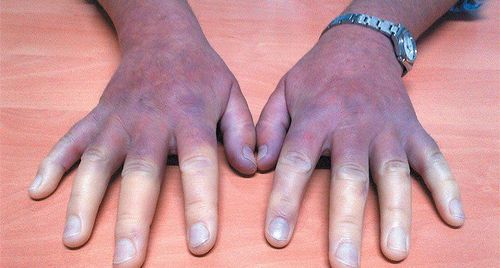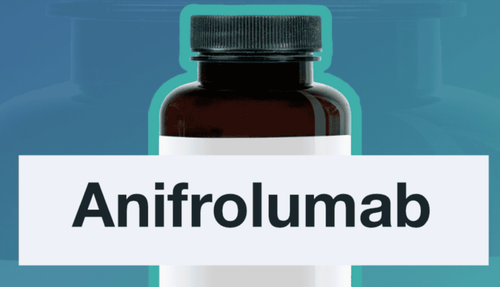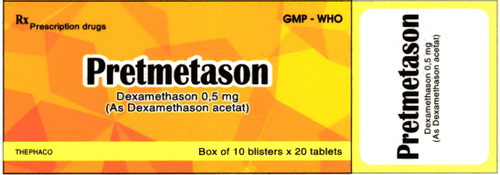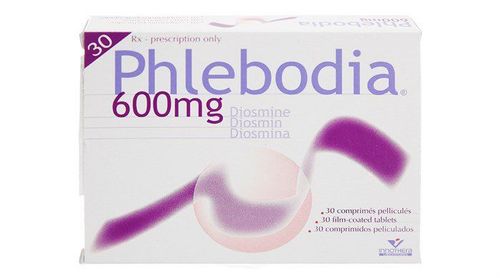This is an automatically translated article.
The article was professionally consulted with Specialist Doctor I Tran Van Sang - Dermatologist - Department of Medical Examination & Internal Medicine - Vinmec Danang International General Hospital.Scleroderma is an autoimmune connective tissue disease. In generalized scleroderma with multisystem systemic involvement, cutaneous signs and symptoms are particularly important because they can be recognized before systemic manifestations, allowing the patient the opportunity to diagnose the disease. Early diagnosis and treatment improve the long-term prognosis.
1. What is systemic scleroderma?
Generalized scleroderma is a chronic autoimmune connective tissue disease, most characterized by Raynaud's phenomenon, skin sclerosis, and nail changes; It can also affect internal organs such as the lungs, digestive tract and kidneys.The cause of scleroderma is so far unclear. However, evidence of pathogenesis has been observed that the inflammatory response causes microvascular damage, macrophage deposition, and immune activation to attack body tissues, causing injury and expression. symptom.
Clinically, with the skin lesions in generalized scleroderma, patients can be divided into two groups with scleroderma with limited skin lesions and diffuse skin lesions. This initial classification step is quite important because patients with diffuse scleroderma have a worse prognosis.
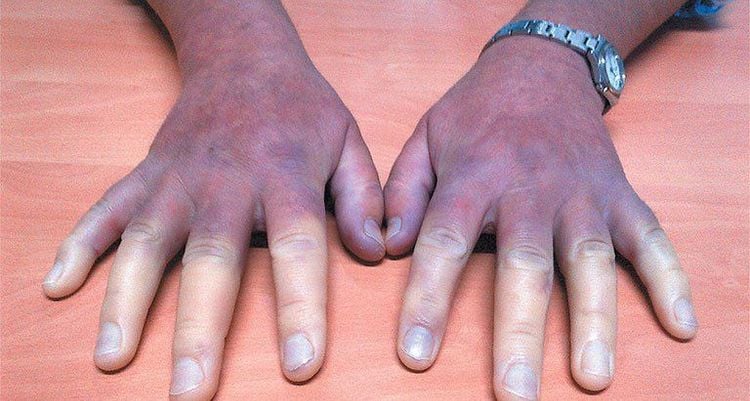
2. What is skin damage in systemic scleroderma?
In the treatment approach, each type of skin lesion will be approached separately in the following forms with different regimens, depending on the pathogenesis.2.1 Raynaud's phenomenon
Raynaud's phenomenon is characterized by skin discoloration caused by blood vessel constriction. This process proceeds in three stages with initial blistering due to vasoconstriction, progressing to painful cyanosis or cyanosis, and finally red swelling when perfusion is restored.Raynaud's phenomenon is usually caused by cold and symmetrical stimuli on the fingertips but can also occur in other locations such as the toes, ears and nose.
This is a sign in more than 95% of patients with generalized scleroderma and is often the earliest sign.
2.2 Ulcers and pitted scars on fingertips
Ulcers and pitting scars on the fingertips can occur as a complication of ischemic or mechanical trauma, in the presence of Raynaud's phenomenon or in the presence of calcified deposits.This type of skin lesion occurs in 32-58% of patients with generalized scleroderma. Because this is a chronic disease, with a long healing time, ulcers and pitting scars on the fingertips can become more complicated if a soft tissue or bone infection is present, requiring aggressive medical or surgical treatment. , sometimes requiring amputation. Therefore, this injury becomes a significant burden for patients in daily life due to impaired hand function and quality of life.

2.3 Skin sclerosis and sclerosis of the fingers
Scleroderma is also the hallmark of skin lesions in generalized scleroderma.In which, the skin on the elbows, knees or even the skin on the face becomes thicker, the fingers and legs harden, difficult to grasp. This lesion typically progresses from an initial edematous stage, lasting 6-12 months, to a sclerotic stage lasting 1-4 years or longer, and finally to a typical lifelong stage of muscular atrophy.
Skin lesions of this type sometimes with or without involvement of skin on the trunk.
2.4 Calcium deposition
Calcium deposition in skin lesions in generalized scleroderma is the result of hydroxyapatite crystal deposition in the extracellular complex of the dermis and subcutaneous tissue. Calcium deposition can also occur on the trunk and cause pain, ulcers, infections, and joint contractures.This is also a chronic lesion with a greater presence in men, sometimes accompanied by visceral lesions or osteoporosis .
2.5 Varicose veins
Varicose veins observed in the skin of patients with generalized scleroderma have no inflammatory mechanism, usually occurring in the posterior surface of the superficial veins in 40-70% of patients.Varicose veins are most commonly found on the face, lips, oral mucosa and hands but can sometimes be observed distributed on the upper body and lower extremities.
Many observational evidence shows that varicose skin lesions are correlated with pulmonary hypertension complications, nail capillary abnormalities in patients with scleroderma.
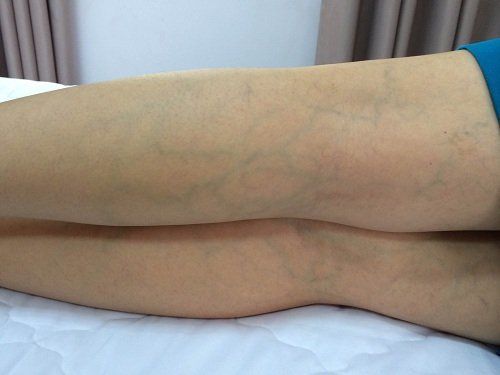
2.6 Itching
Itching in generalized scleroderma affects a lot of patients' lives, causing depression, insomnia and long-term fatigue with the rate affecting more than 40% of patients.This symptom is associated with a poor prognosis for skin lesions, most commonly noted on the head, back, back of the hands, and extremities. Itching tends to be aggravated by eczema when the patient scratches the skin.
2.7 Pigmentation disorders
Hyperpigmentation is commonly observed in patients with generalized scleroderma in more than 50% of patients.Patches of pigment abnormalities can be as diverse as diffuse and photosensitive hyperpigmentation, peri-pigmentation around damaged or sclerotic sites, or focal vitiligo-like hypopigmentation . The most commonly affected skin areas are the scalp, forehead, neck, hands, and extensor side of the extremities.
In some cases, these signs can help detect scleroderma early.
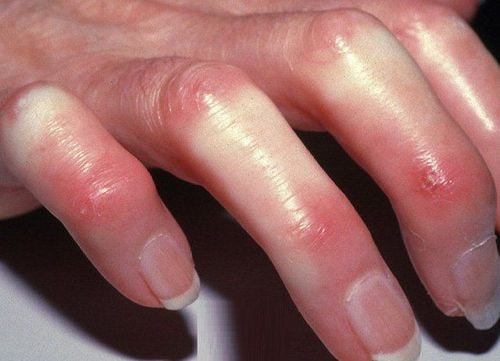
2.8 Changing nails
Skin lesions in generalized scleroderma can affect the nails, with onychomycosis and nail thickening being the most common, with nail changes occurring in more than 80% of patients.Besides, nails can also be rough, thick or deformed such as racquet nails, parrot beak nails, concave nails. The mechanism of nail damage is a consequence of microvascular pathology, including vasospasm and calcium deposition.
3. What is the prognosis of skin lesions in systemic scleroderma?
Generalized scleroderma with skin lesions generally has a poor prognosis, with a mortality rate 2.7 times higher than in the general population of the same sex and age.The cause of death in these subjects is usually heart and lung complications rather than skin lesions themselves. However, skin damage in generalized scleroderma causes a loss of quality of life many times higher than in the general population or even in scleroderma patients without skin lesions.

4. Treatment of skin lesions in systemic scleroderma
Treatment of skin lesions in generalized scleroderma requires a combination of multiple modalities and needs to be tailored to each type of lesion.However, the first thing the patient must know how to make lifestyle modifications, most importantly, prevent triggers, such as cold or wet temperatures, stay warm, and wear gloves. If you smoke, you need to quit. Sometimes some topical products help moisturize, reduce itching, so they also help improve skin fibrosis.
At the same time, the drugs that can be used are calcium channel blockers, phosphodiesterase-5 inhibitors, prostanoids, endothelin-1 receptor antagonists, fluoxetine. Anti-inflammatory agents such as methotrexate, infliximab, rituximab, corticosteroids, or intravenous immunoglobulins may be considered when skin lesions are concomitant with severe visceral complications, which can be life-threatening.
Several other methods are being considered depending on the situation such as phototherapy, surgery to remove calcium deposits or even hematopoietic stem cell transplantation ...
In short, scleroderma is a disease Chronic autoimmune disease requires a multidisciplinary approach and coordination to treat and care for patients. For skin lesions in generalized scleroderma, although evidence-based treatment options are still limited at this time, current modalities are still significant in terms of symptom relief and improvement. improve the quality of life for patients.
Please dial HOTLINE for more information or register for an appointment HERE. Download MyVinmec app to make appointments faster and to manage your bookings easily.





